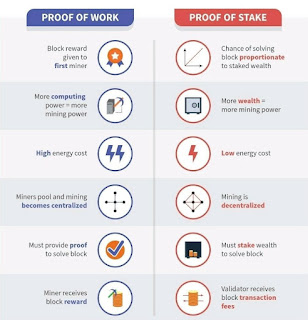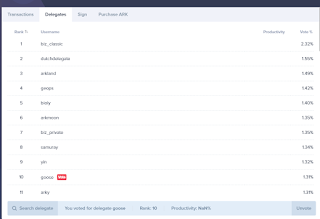Adventures in Staking: Part 1 - NEBL, NAV, and WAVES
This article is about my experiences and returns on staking various cryptocurrencies over the past year or so. Unfortunately, my timing was not so great, as many of these coins were purchased in the first half of 2018 and all have lost considerable value since then, some as much as 85%!
This taints the experience a bit. So, to counteract those unfortunate circumstances, my discussion of any returns in this article (both parts), will be focused on gains in number of coins I own, leaving out their value vs Bitcoin, USD, or any other currency.
That being said, onwards!
===========
Most folks have at least heard of the concept of mining Bitcoin (otherwise known as Proof of Work), though they may have no idea what it means. Basically, it's a way of using computer processing power to help process Bitcoin transactions and in return, receive newly minted coins as a reward. However, this method of cryptocurrency generation and maintenance has rapidly devolved so that it is only available to those who have the capital to invest in expensive machines that are dedicated solely to mining, and often ends up centralized in a few mining behemoths.
 |
| Proof of Work vs. Proof of Stake | credits: dlbx.io |
But there is another method of coin generation, called Proof of Staking. Simply put, Staking is a way to earn interest on your holdings. The exact methods vary a bit between coins, but the primary concept is still the same. You hold some coins for a time, and get a return on what you are holding. Kind of like a savings bond.
This idea has actually been around and used for quite a while. But previously, it was limited to those willing to run a 'masternode', which could often cost tens of thousands of dollars. Certainly not something that fell in my financial realm. But now there were coins that had no lower limit of the amount you could stake.
This idea sounded right up my alley. I buy some coins, sit back, and watch the profits roll in. Passive income for the win! Let's do this thing!
Neblio and NavCoin
I lump these two coins together as they were the first coins I elected to use in my staking experiments, and my experience with both was pretty similar.
They both use a system I refer to as Active Staking, which requires that you have a client program running and connected to the network in order to have a chance at the rewards. They also require that you have 'mature' coins in your wallet. For coins to mature, they have to be marked as available for staking and remain at the same address on the network for a period of time. The idea here is to prevent temporary nodes from coming and going too often.
First up was Neblio, which claims a 10% return per year. Not huge, but significantly better than anything a bank, bond or CD will offer. I happened to have a few Neblio sitting around on my Binance account after my frenzy of altcoin purchases. Not a huge amount, but one of the reasons I chose Neblio was that there was no minimum amount required for staking.
The wallet was easy enough to download and install, though there is the prerequisite wait while the entirety of the blockchain is transferred over, which ended up taking several days. Once that was done, I sent my Neblio coins to the wallet address and told the blockchain that I wanted to start staking (via simple selection from a standard drop-down menu). After waiting the prerequisite week for my coins to mature, I was in the mix!
Once your coins hit the weight limit, then it's just random luck, based on the size of your holdings. That last part is probably the most significant. My measly pouch of coins is surely tiny in the face of the entire ecosystem, but I was expecting some sort of trickle of coins to come my way. However, the client was estimating that I would be rewarded in over 300 days!
Navcoin setup was similar, though they didn't provide an estimate on when awards might be given out. I soldiered onward, sacrificing my system to running and maintaining both the clients running 24/7. I eagerly checked for income on a regular basis but nothing ever arrived. I left them running for weeks at first. Still nothing. Finally, one day, a minuscule amount of Neblio arrives in my wallet. While it's great to see something actually happening, the amount is only worth about 9/1000ths of a cent. This doesn't seem so great. (I later find out that this was actually some token called TRIF arriving in my wallet, the client just didn't know how to report it correctly).
Coincidentally, as I'm still grumbling over my negligible Neblio staking reward, I get a pop-up message from the Navcoin client! Hell yeah! Let's see what I get here... Hey! It's a 10% return... er... that doesn't seem quite right. Would be nice, but I suspect something might be amiss.
Sure enough, the transaction never actually goes through. I inquire on the Reddit forum and find out that others saw similar ghost transactions. Bah! I don't have a dedicated machine for this venture and the clients are both pretty big memory hogs (Neblio takes up 400 meg, Navcoin nearly 2 gig!) so shutting them down to use my computer for something other than email and then restarting them every night gets tedious. I eventually gave up and simply stopped running both of the wallets.
...
Months later, I decide to fire up Neblio again and received an almost immediate notification of a reward! What's this!? I was very surprised to say the least. Excited and hopeful, I left the client open to see what would happen. Sure enough, a few days later another reward appeared, though this one was much smaller and closer to what I would have expected. I began to wonder what had changed, why my minuscule staking pile had suddenly became viable. I noticed that my Neblio client was out of date. Hmmmm. Surely that couldn't be causing me to get false reward notifications, could it? Well, as it turns out, it could. I fired up the block explorer and my fears were confirmed! The blockchain had no record of my mining reward transaction. #@&^%&%!
I updated to the new client and found myself right back to where I had been six months prior. My newly granted staking rewards were gone, my coins were at full weight and my expected reward time was still greater than 300 days. Double bah! What BS! I'm guessing these false positives were related to hard forks in the code, but damn if it wasn't frustrating!
Almost the exact same thing happens to me with Navcoin, and for a second time I abandon my attempts to run the nodes on a regular basis.
In late November, I make another attempt. Right before Thanksgiving, I started up both clients, set them to staking and left them and my computer running. After about a month, I received a reward on NavCoin! Still scarred from my previous experiences recieving mining rewards, I'm cautious. I wait and make sure that the coins are fully credited on my wallet and in the blockchain explorer. Success!
Hey, look at that! After 10 months I was finally rewarded for my travails! Then two weeks later another award arrived, and a third a day after that! At around the same time, I suddenly received a reward in the Neblio client as well, pretty much exactly 10% of my staked coins, and on the 1 year anniversary of my initial staking setup. Interesting.
Alas, my rewards seemed to dry up after that. Again I slack off and stop running the clients. In preparation for publishing this article I dust off both programs and once again receive some ghost tokens and go through the discovery that I am using an older version that is apparently incompatible with the current network. Sigh. Perhaps this job is not for me.
My returns for Neblio were exactly 10% after exactly 1 year, as mentioned above. Navcoin has only given me returns of 3.2%
, scammers abound. It is ludicrous how many spam and scam coins are created and sent to my portfolio.
I almost did! But despite it seeming official, I luckily held back! Those coins turned out to be scams and a number of unlucky souls had their wallets cleared out! I managed to escape without harm, but the barrage of scam coins landing in my wallet continued unabated.
hough apparently, she is worthless.
can only assume that it is for some nefarious reason. To be honest, I have done zero research on the matter. I'm just jumping to conclusions.
0.2% return in Waves. About an additional 1% return in value if you count up the various reward tokens. Perhaps I've chosen poorly in delegates. I've switched leasing pools again. We'll see if I like the new one any better.



Thanks For This Informative Article. It Helps All Those People Who Are Confused about the crypto market.
ReplyDeleteCrypto Free Airdrops
well, that's a great blog. Really so much impressive and i love that type of post. thank you.
ReplyDeleteIf you searching for a legit financial service .Check it out. Link below.
legit dark web
Unclaimed Mystery Box
legit PayPal transfer dark web
dark web financial services .
Please carry on and keep blogging . Thanks again